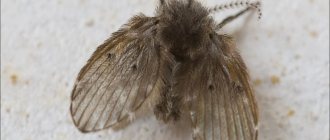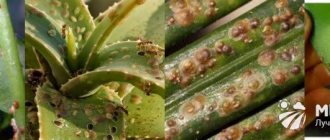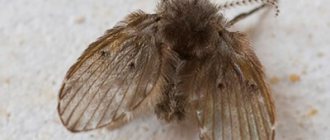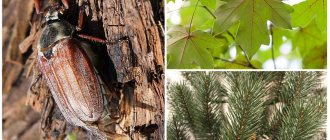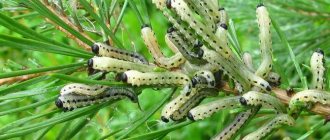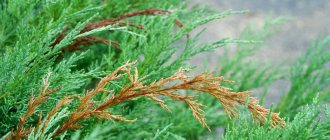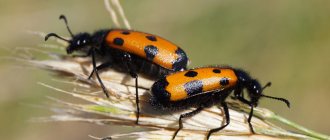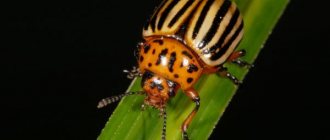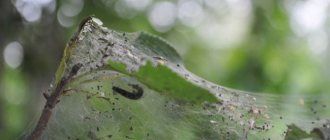To win a confident victory, you need to know the enemy by sight. This statement is true not only on the battlefield, but also in the garden. We talk about how to detect an “uninvited guest” on your site, and how to treat your garden against pests.
Timely adoption of measures to search for and “neutralize” the enemy gives a chance to save the harvest. For convenience, we have divided pests into groups depending on what garden crops each person prefers.
Pests of raspberries, blackberries and strawberries
For your attention - the most common representatives of the fauna, which, like many summer residents, are not averse to profiting from sweet berries (and not only them).
Pest[/td]
| How to recognize | Control measures | |
| Strawberry whitefly | Adult insects “nest” on the underside of leaves. Honeydew (honeydew) is noticeable on the surface of the leaf; later, black spots of sooty fungus spores are visible in its place. | Biological The pest is washed off the leaves with water, then the soil is loosened to a depth of 2-3 cm. Traps are made: a sheet of plywood is painted yellow and smeared with Vaseline. The leaves are treated with a soap solution: 1 part soap shavings to 6 parts water. The parasite encarsia is released into the garden (3 individuals per 1 sq.m.). Chemical Spraying plants with Actellik and Confidor. |
| Strawberry nematode | The insect settles in the axils of leaves and buds. Ovaries, buds and flowers curl and rot. The leaves darken, the petioles turn red. The plant stops growing. | Biological Maintaining crop rotation. Removing weak and diseased plants. Thermal treatment of roots: a bush affected by a nematode is removed from the soil and washed with water or soaked in water at a temperature of 50-55°C. Planting resistant strawberry varieties (for example, Festivalnaya). Chemical Treatment of plants with Fundazol, Nemagon, Skor, Carbation, Maxim, etc. |
| Strawberry mite | The leaves curl, wrinkle and turn yellow, and a waxy coating appears on the surface. Later, the affected parts of the plant die. The pest is more active in northern regions with cold climates than in the south. | Biological Thinning of plantings, regular weeding. Treatment with infusion of onion peel (200 g of peel, pour 10 liters of warm water, leave for 4 days) or garlic extract (200 g of chopped garlic, pour 10 liters of water, stir, strain). Chemical Treatment of plantings with Karate Zeon insecticide (5 ml per 10 liters of water). Spraying with Karbofos solution is effective. |
| Strawberry leaf beetle | The pest eats away the pulp of the leaves, leaving the skin intact. The bush withers, dries up, and stops bearing fruit. | Biological Do not allow strawberries to be adjacent to meadowsweet and cinquefoil - these are the “homes” of the pest. Regular loosening of the soil is mandatory. Chemical Before flowering, the plantings are treated with pesticides: Karate, Karbofos. |
| Raspberry bud moth | The pest eats away buds and young shoots. The affected parts of the plant dry out. | Biological Thinning of plantings, clearing the area of debris. Treatment of raspberries with wormwood infusion: 800 g of dried herb (or 0.5 buckets of raw) pour 10 liters of water, leave for 24 hours. Then boil, strain, dilute by 2 times. Chemical At the stage of bud swelling, the bushes are sprayed with Chlorophos solution (30 g per 10 liters of water). |
| Raspberry stem gall midge | The pest lays eggs closer to the base of the stem. A typical sign of damage is swellings (galls) on the stems of the plant. | Biological Affected parts of plants must be removed. The insect is repelled by the smell of garlic and onions, so it is advisable to plant these crops near the raspberry tree. Chemical Twice during the planting season the plantings are sprayed with a 0.3% solution of Chlorophos: the first time in the spring (when the soil warms up to 13°C), the second time 10 days later. |
| Raspberry stem fly | Pest larvae leave tunnels in the shoots. The stems of the plant darken and dry out. | Biological Affected shoots are cut out and burned. In the fall, the soil under the bushes is dug up and pruning is carried out in a timely manner. Chemical Treatment with 1% Bordeaux mixture. Spraying with Iskra, Karbofos, Actellik, Inta-Vir, etc. is effective. |
| Raspberry-strawberry weevil | Small punctures are noticeable on the leaves, the buds weaken and wither (the pest gnaws the pedicels). | Biological Mandatory destruction of plant residues at the end of the season. Treatment with wood ash infusion (pour 3 kg of boiling water over 10 liters, add 40 g of soap shavings, stir, leave for 12 hours). Chemical Before and after flowering, plants are treated with Iskra-M, Karbofos-500, Alatar, Taran, Fury, Fufanon-Nova. |
| Raspberry beetle | The pest larva can be seen by picking a berry from a bush. The insect damages flowers, ovaries, and young leaves. | Biological During deep (20 cm) loosening, tobacco dust is added to the soil. Garlic and onions are planted in raspberry fields to attract predators to the area - hoverflies and ground beetles. Plants are treated with tansy infusion (400 g per 5 liters of water, leave for 24 hours, then boil, strain and dilute to 10 liters). Before flowering, the bushes are sprayed with 2% Bitoxibacillin. Chemical Treatment with Inta-Vir, Kinmiks, Konfidor, Iskra-M. The approximate consumption of the working solution is 1.5 liters per 10 bushes. |
| Raspberry mite | The mite can be found on the underside of a young leaf. The pest feeds on the sap of the plant, causing the leaves to become deformed and covered with light spots. | Biological Spraying with onion infusion: pour 20 g into 1 liter of water, stir, leave for 7-8 hours, strain. Chemical Treatment of bushes by leaves with Fufanon, Karbofos, Iskra-M, Actellik, etc. (dosage according to instructions). |
Strawberry pests: how to recognize and fight
Garden strawberries (strawberries) are an attractive “target” for many pests, the most dangerous of which we will talk about today.
Who eats raspberries - 5 most dangerous pests
What raspberry pests are considered the most dangerous, and why are they so difficult to detect? Find out from the article right now.
Barbel
You can often see a long black beetle running around the house. He is known to science as the brownie woodcutter. This species of long-horned beetle has long become an unpleasant companion for humans. In wooden houses, it lays its larvae in floorboards, window frames, partitions, in the roof, and sometimes in furniture. The larvae leave behind woody brown dust. There are cases where, during the mass reproduction of longhorned beetles, entire houses fell into disrepair.
In order to scare away their enemy, these insects can make creaking sounds.
Pests of apple and pear trees
But those who unceremoniously invade your domain to feast on some of the most popular garden crops in our latitudes.
| Pest | How to recognize | Control measures |
| Pear gall mite | Light green swellings form on the leaves, which darken over time to a reddish-brown color. The pest “lurks” on the back of the leaf. | Biological In the fall, it is necessary to clean tree trunks of old dead bark and whiten them. Chemical Before the buds bloom, the tree crowns are sprayed with Inta-Vir or Decis (1 tablet per 10 liters of water). In summer the treatment is repeated. |
| Pear fruit sawfly | The larvae feed on the ovaries and eat the seeds. Damaged fruits turn black and fall off. | Biological In early spring and at the end of the season, you need to dig up the soil in the tree trunk circles so that the insects wintering there die. The trunks are cleared of old bark. Chemical Before flowering and immediately after it - treatment with a 10% solution of Karbofos. Spraying the crowns with 1% colloidal sulfur is effective. |
| Green apple aphid | The plant slows down, the fruits grow small and fall prematurely. Honey dew is noticeable on the leaves. | Biological Regular destruction of root shoots and fattening shoots. Before the buds open, the branches of the tree are treated with a mixture of kerosene and liquid soap (ratio –1:1). Chemical Treatment of the garden with Oleocuprit, Trichlorometaphos-3, Inta-Vir, Tabazol and other insecticides. |
| Goldentail | The pest in the caterpillar stage eats the buds and leaves of trees. | Biological In the fall, you can destroy insects that have settled in for the winter. Nests braided with dense cobwebs are easy to spot on tree branches. Chemical Spraying with Karate, Mospilan, Prestige, Inta-Vir, etc. |
| Red gall aphid | Reddish swollen spots appear on leaves and fruits. | Biological In general, control methods are the same as in the case of other types of aphids. Dill, tansy, and cosmos are planted in tree trunk circles to attract beneficial insects to the area. At the beginning of the season, hunting belts are put on the trunks. Chemical Treatment with Karbofos, Fufanon, Bi-58 Novy, Aktara, etc. is effective. |
| Red and brown fruit mites | The leaves become covered with a reddish coating or cobwebs (red mite), the bark takes on a silvery tint (brown mite). Light spots appear, then the leaves fall off. | Biological Destruction of plant waste, digging up soil in tree trunk circles. Chemical Treating trees with Oleocuprit, Karbofos, etc. The drugs must be alternated. |
| Apple and pear moths | The pest damages the fruits by eating the seeds. Black dots are noticeable on apples and pears, and passages are visible in the cross-section. | Biological Cleaning the tree trunk from old bark at the beginning and end of the season. Planting tomatoes near trees (their smell repels the pest). Use of pheromone traps. Chemical Treatment of the garden with preparations Match, Karate Zeon, Sirocco, Bean, etc. |
| Apple sucker | The pest feeds on the sap of the plant, the tree begins to weaken, the buds fall off, and the fruits become smaller. Honeydew is visible on the shoots, which is later “settled” by sooty fungus. | Biological Fumigation of trees with tobacco smoke. Treatment with infusion of hot capsicum (1 kg boiled in 10 liters of water for an hour, left for 2 days, filtered). 130 g of concentrate is diluted in 10 liters of water, 40 g of soap shavings are added and the plants are sprayed. The remaining concentrate can be stored in bottles. Chemical Spraying trees with Oleocuprit, Kemifos, Metafos, Cyanox, Ambush (according to the instructions). |
| Apple moth | The pest eats the pulp of the leaves and entwines them with cobwebs. Ovipositions covered with mucus can be seen on the branches. | Biological Biological insecticides Bitoxibacillin (70 g per 10 l of water) and Lepidocid (30 g per 10 l of water) are used. Pheromone traps are used. Chemical Spraying trees with Phosfamide, Inta-Vir, Actellik, Kinmiks, etc. |
| Apple glass | Caterpillars make passages under the bark. The bark dies, the tree weakens and dies. | Biological Treating wounds on tree bark with a mixture of clay and mullein, removing the affected areas of the bark (it is cut off, then the surface is treated with a 1% solution of copper sulfate and wrapped in cotton cloth). Chemical Treatment with Vofatox, Cidial, Metaphos, Cyanox, etc. |
| Apple moth aphid | Leaves turn red, curl and die, branches stop growing, fruits become deformed. | Biological Trees are treated with a soap solution (300 g of soap shavings per 10 liters of water). Chemical Before the buds open, the garden is treated with Olekokuprit, Iskra, Bi-58, Ditox, Kinmiks, Karbofos-500, Novaktion, etc. To get rid of larvae, trees are sprayed with Decis, Vofatox, Phosfamide, etc., before flowering. |
| Apple flower beetle (weevil) and goose | Punctures are visible on the kidneys, from which fluid is released in drops. The buds fade and dry up | Biological In late autumn, they dig up the soil in tree trunk circles and destroy plant debris. Chemical During the period of bud release, trees are sprayed with Fufanon, Corsair, Karbofos, Tanrek. |
How to protect apple and pear trees from diseases and pests?
The most effective ways to combat common diseases and pests of apple and pear trees.
Spider mite
The invasion of small red bugs in the garden in the ground or on the leaves of fruit trees means the appearance of spider mites in the garden plot. Their main diet consists of plant juices, which they extract from leaves and young shoots. The result of parasitism is damaged plant parts covered with a thin white cobweb.
The size of red mites is no more than 1 mm, but they live in large colonies and can cause significant damage to garden crops. The leaves begin to become stained, turn yellow, the plant becomes very weak and suffers from a lack of chlorophyll.
In the fight against insect pests of gardens in this situation, treatments with soap solution, garlic or onion infusion help. Insecticides (Aktellik, Neoron) and biological products (Fitoverm, etc.) are used as insecticides.
Pests of currants and gooseberries
Before you are the most daring invaders of currant and gooseberry bushes, which, nevertheless, even a novice gardener can cope with.
| Pest | How to recognize | Control measures |
| Yellow gooseberry and blackcurrant berry (fruit) sawflies | The yellow gooseberry sawfly eats the pulp of the leaves. The blackcurrant fruit sawfly feeds on berries. The fruits become ribbed. | Biological Infected fruits are removed from the bush and destroyed. Plant remains are destroyed. The bushes are hilled and mulched with a layer of 8 cm. Chemical After flowering, the bushes are sprayed with Actellik, Etafos, Karbofos, etc. |
| Gooseberry shoot aphid | The leaves curl into clumps, then begin to dry out and die. The branches become bent and stop growing. | Biological Affected shoots are destroyed. They release the aphid parasite, Aphelinus. Treat with Fitoverm (1 ml per 10 liters of water) or mustard infusion: pour 10 g of powder into 1 liter of water, leave for 2 days, strain. Then dilute 200 ml of solution with water to 1 liter. Chemical Treatment of bushes with Decis, Aktara, Fufanon is effective. |
| Gooseberry moth | Leaves and buds are chewed by the pest. Oviposition can be found on the reverse side of the leaf. | Biological Regular loosening of the soil under the bushes. Treatment of plants with biological insecticides: Lepidocide (50 g per 10 l of water), Bitoxibacillin (100 g per 10 l of water). Chemical Spraying plants with Karbofos, Inta-Vir, Bromophos, etc. |
| Leaf gall aphid | The pest “settles” on the underside of the leaf. Reddish swellings (galls) are visible on the top of the leaves. Then the foliage dies off and the yield of the bush decreases. | Biological Affected parts of plants are cut off and burned. Plants that repel aphids are planted near the bushes: dill, alyssum, caraway seeds, marigolds. Chemical During bud break, after flowering and after harvesting, the plants are sprayed with Actofit, Enzhio, Aktara, etc. The bushes are treated with a solution of soda ash (1 tbsp per 10 liters of water). |
| Ognevka | The leaves are damaged and covered with cobwebs, the berries are eaten by the pest. | Biological The soil under the bushes is carefully loosened and mulched with compost or peat, and the bushes are hilled. Plants are sprayed with 1% Bitoxibacillin or 0.3% Lepidocide. Chemical Treatment before flowering with Fufanon-Nova, Iskra. |
| Bud moth | The pest eats out buds on red and white (less often black) currant bushes. It lays eggs on the reverse side of the leaf. | Biological Mandatory removal of plant residues at the end of the season. Chemical Treatment with a 0.1% Aktara solution or Iskra-M, Novaktion, Fufanon Expert. |
| Currant gall midge | The leaves become deformed (swelling appears) and dry out. Cracks and spots are noticeable on the branches; later the shoots dry out and die. | Biological Damaged shoots are removed, the bushes are treated with a solution of Bitoxibacillin (100 g per 10 l of water) or Lepidocide (50 g per 10 l of water). A gall midge parasite, the anthocoris bug, is released into the garden. Chemical Treatment of bushes with Kemifos, Actellik, Fufanon, etc. |
| Currant aphid | Swollen spots of a reddish color form on the leaves, and young shoots become bent. Pest colonies can be found on the reverse side of the leaf. | Biological Before the buds open, the pest can be washed off the bushes with hot water. Chemical Treatment with Aktara, Inta-Vir, Fufanon, Insektor, Decis, Bi-58, etc. |
Pests of currants and gooseberries - photos, descriptions, how to treat the bushes
Find out how to protect your favorite berries from dangerous insects.
Trichogramma (egg-eaters)
A simple hunting mechanism is also used by egg-eating riders. The insects themselves feed on nectar and look quite decent, but their larvae parasitize the eggs of other insects. Trichogramma leaves without offspring the cabbage whitefly, codling moth, meadow moth, fall armyworm, gooseberry sawfly and other lepidoptera.
The main beauty of trichograms is that you can buy them. Of course, not in a garden store, but in special laboratories, but the trouble is worth it. Each individual released onto the site will produce so many offspring that at least a thousand pest eggs will be damaged.
Pests of cherries and sweet cherries
These are those on whose, let’s say, “conscience” lies the blame for the damage to the sweet cherry harvest. Carefully inspect the trees in the garden!
| Pest | How to recognize | Control measures |
| cherry fly | The fruits darken and soften. Later, small depressions appear on the surface. | Biological Damaged fruits must be removed from the tree and destroyed. With a small number of individuals, sticky traps will help. Chemical Effective treatment with Karate, Lightning, Spark. |
| Cherry shoot moth | The buds die before they have time to bloom, or produce deformed leaves. The pest eats the ovaries, leaving lumps of cobwebs in their place. | Biological Digging the soil in tree trunk circles in mid-June. Collection and destruction of dry branches and fallen leaves. Chemical At the stages of bud break and budding, trees are treated with Iskra, Karbofos, Fufanon Nova, Preparation 30 Plus (before bud break). |
| Cherry aphid | The leaves curl in a spiral, then darken and dry out. | Biological Ladybugs are lured to the site and ants are eliminated. Plants are treated with Fitoverm or wood ash infusion: pour 500 g into 5 liters of water, leave for 3 days, then add water to 10 liters. Chemical The drugs used are Iskra, Komandor, Fufanon-Nova, Fufanon Expert, Novaktion, Inta-Ts-M. |
| Cherry weevil (pipeweevil) | The pest attacks the buds, eating away their core. The larvae spoil the fruit seeds. | Biological Autumn digging of the soil at least 20 cm deep. Destruction of plant residues. Chemical Before flowering, trees are treated with Decis, Fastak, Karate. After flowering, Aktara, Iskra, and Lightning are used. |
| Cherry leaf beetle | The pest spoils the leaves and ovaries. | Biological Larvae and adults are collected by hand and destroyed. The affected parts of the plants are removed. Chemical Before the buds open and after the cherry blossoms, they are treated with Karbofos, Kemifos or Fufanon. |
| Cherry slimy sawfly | The insect eats the pulp of the leaves, leaving them skeletonized. | Biological At the end of the season, the tree trunk circle is filled with a layer of clay (1-2 cm thick). The trees are treated with chamomile infusion: 800 g of dry inflorescences are poured into 10 liters of water, left for a day, then filtered, diluted to 30 liters and 50 g of soap shavings are added. They also release the sawfly parasite, Trichogramma. Chemical Trees are treated with Iskra-M, Decis, Karate. |
Pests of cherries and cherries - how to recognize and fight
Find out which pests deprive you of your cherry and cherry harvest from year to year.
Longhorned beetle: description
The barbel is known to some under the second name “woodcutter”. It has many varieties, but in our area the black beetle is more common. In the CIS countries they are very common, and there are 583 species. But besides this, longhorned beetles are well known anywhere on the planet. This is due to the fact that the insect feeds on woody plants, which are found in all parts of the earth.
It is easy to recognize in nature, since it is an elongated black beetle with antennae that are almost four times the height of the insect itself. But in females they are slightly shorter and no longer than the body. They are of average size, although in some parts of the world you can meet giants. For example, the titan beetle belonging to this genus lives in South America. It grows up to 21 cm! In some places in Russia you can find an 11-centimeter long lumberjack, which is called the Ussuri relict barbel. But the black beetle, which we encounter most often, is of medium size. Often you can see developed protruding mandibles on its head. It is worth noting that some types do not have such advantages. Also, many longhorned beetles are not capable of flight. It is worth noting that the woodcutter’s colors are not only black. Their colors range from yellow to resin. Some of the backs are decorated with a pattern.
Pests of plum, cherry plum, peach and apricot
Plum jam, apricot marmalade and cherry plum adjika - you risk losing all of this if you don’t take care of eliminating pests in your garden.
| Pest | How to recognize | Control measures |
| Plum moth | The pest feeds on plum pulp. The fruits do not have time to ripen and fall to the ground. | Biological Regular loosening of tree trunk circles. Removal of weeds and root shoots, sanitary pruning of trees. Chemical The trees are treated with Fufanon-Nova. |
| Plum pollinated (reed) aphid | Pest colonies cover the branches and leaves of plants. A bluish coating is noticeable on the foliage. | Biological Destruction of “tops” and root shoots. Chemical Treatment with Karbofos, Kinmiks, Fufanon-Nova, Inta-Ts-M or Novaktion. |
| Plum papilion | The pest eats away the seed from the fruit, causing the unripe plums to fall off. | Biological Collection and destruction of carrion. Autumn digging of soil in tree trunk circles. Chemical Treatment with Confidor Maxi, Calypso, Bi-58, Dantop, etc. |
| Plum gall mite | Reddish swellings (galls) appear on young shoots. | Biological Damaged branches are removed. Predatory mites of the family Phytoseiidae are released into the garden. Chemical Treatment with a solution of colloidal sulfur (40 g per 10 liters of water) or Tedion (according to instructions). |
| Black and yellow plum (fruit) sawflies | The pest eats away the pulp of the ovaries and gnaws out the plum pit. The fruits fall from the tree prematurely. | Biological In the fall, they dig up and loosen the soil in tree trunk circles. Insects are collected by hand and destroyed. Chemical Trees are sprayed with Novaktion, Tarzan, Insegar. |
The most dangerous plum pests and how to combat them
Description and photo of insects that can leave a gardener without a plum harvest.
Krawczyk
Another large black beetle that is familiar to many gardeners is the loggerhead.
It, like most other pests, has several names: stag beetle, snow beetle and bighead beetle. This insect grows up to 2.5 cm. It can be recognized by its stocky, dense body and large head. The insect's wings are not developed. It also differs in its behavior. “Rogach” cuts off the sprouts and, backing away, drags them underground into its burrow, which can go deep up to 40 cm. Also, this black beetle (photo offered above) has massive mandibles that help it wreak havoc.
Grape pests
Do you love grapes as much as these pests “love” them? Take urgent measures to prevent your vineyard from dying!
| Pest | How to recognize | Control measures |
| Grape, grape and biennial leafrollers | The pest eats different parts of the plant: ovaries, buds, leaves, berries, buds. A sticky web is visible on the grape bunches. | Biological Regular collection and destruction of old exfoliated bark and fallen leaves. Use of pheromone traps. Chemical The vineyard is treated with the drugs Decis, Confidor, Inta-Vir, Fufanon, Arrivo, etc. A month before harvest, Sumicidin and Tsimbush are used. |
| Grape leaf mite | It feeds on the buds of the plant; as a result, the bush produces weak, crooked shoots. The leaves are wrinkled, as if cut into strips. | Biological The affected parts are removed. Plant residues are regularly destroyed. Chemical Acaricides are used: Actellik, Omite, Bi-58, Neoron. The vineyard is treated with insecticides Karate and Fozalon. |
| Grape spider mite | Eats grape leaves. Colonies live on the underside of the leaf. | |
| Grape thrips | The upper part of the shoots is deformed, the branches are covered with dots. Small swellings and light spots appear on the underside of the leaf. | Biological Using glue traps in blue and yellow colors. Chemical Spraying bushes with Ridomil, Fury, Bi-58, etc. |
| Itch, or felt mite | Depressed spots on the leaves, covered with a light fluffy coating. Then the coating darkens to brown, the leaves become as if covered with felt. | Biological Damaged leaves are torn off, plant debris after pruning is destroyed. Treatment with Vertimek. Chemical The leaves are sprayed on both sides with Omite, Actellik or Tiovit Jet. |
| Phylloxera | The larvae pierce the plant tissue and feed on its sap; swellings appear on the roots. Bushes die from infection with infectious diseases. | Biological Catarovka - removal of surface roots (at a depth of less than 20 cm). Growing pest-resistant varieties: Mtsvane, Greek pink, Jubilee of Moldova, etc. Chemical Before planting, seedlings are treated with insecticides Fufanon, Bi-58, etc. Twice per season they are treated with Actellik, Fastak, etc. |
The most dangerous grape pests (description and control methods)
Grape pests are often mistaken for harmless moths or are not noticed at all. And at this time, the harvest is in serious danger.
Beneficial insects in the garden (entomophages)
In addition to pests, there are beneficial insects at the dacha. You also need to know them so as not to accidentally destroy them.
Lacewing
A small green midge with transparent wings is a predator. Its larvae feed on insects harmful to the garden.
Little fairy
In farms aimed at producing environmentally friendly agricultural products, greenhouses are specially populated with lacewings. This allows you to stop using pesticides.
Ladybug
Coccinellidae is a predator that is not interested in garden and garden crops. The beetle larvae are very voracious - each is capable of destroying several hundred aphids.
Towards a good harvest
The menu includes:
- spider mite;
- California scale insect;
- mealybug.
Stethorus, a small bug belonging to the ladybird family, reliably protects cucumber beds and berry gardens from spider mites. It feeds on the pest at all stages of its development.
If you populate plantings with stetorus, the need for insecticides will completely disappear. One individual is capable of destroying from several hundred to 1-2 thousand spider mites.
Trichogramma
The insect destroys pest eggs. The female uses them for her clutch, and Trichogramma larvae hatch there. In fact, they are parasites, as they eat the embryos of codling moths, cutworms, moths, and white moths.
Destroys pests at the egg stage
They are not dangerous to aphids and various types of fleas. It will not be possible to completely abandon the use of chemicals on cabbage by populating the plantation with Trichogramma.
Ground beetle
At two stages of their development, ground beetles (Carabidae) are dangerous to other insects. Adult beetles and larvae will protect vegetables, flowers, and trees from plant pests.
Such bugs must be protected
There are species that feed on snails and slugs. Ground beetles destroy gypsy moths and eat caterpillars and pupae of various insects.
Thanks to its powerful mouthparts, the beetle copes with the chitinous cover of most pests that are dangerous to gardens, flower beds and vegetable gardens.
Among insects there are those who destroy the crop and those who help fight for it. To rid the area of pests, it is necessary to attract gardeners (beneficial beetles and flies) to it and carry out treatments in a timely manner.
Author: Alena Ra
Predatory hoverflies
Another insect with questionable benefits is hover flies. Outwardly, they look like wasps or bees, but they move differently and, when hovering in the air, they make a characteristic sound, for which they got their name. Adults feed on nectar, but larvae can feed on both plant foods and insect pests.
It is the second variety that is predatory and is necessary in the fight against aphids and psyllids. Hoverfly larvae reach 12 mm in length and are actively growing, which means they eat a lot. In a day, such a baby is capable of destroying up to two hundred aphids.
And of course, remember that treating the area with pesticides kills not only pests, but also your little helpers, so resort to it only if absolutely necessary.
Source
Preventive measures
The shelves of kitchen cabinets should be wiped with a soda or vinegar solution once a week. Lemon juice with water or an aqueous solution of lavender essential oil are good for these purposes. It is recommended to store cereals, flour, and pasta in tightly closed plastic or iron containers.
It is better to treat new wooden furniture with an insecticide immediately after purchase. It is important to monitor the level of humidity in the apartment, regularly ventilate the room, and wash the floors and walls. When buying bulk products in a store, carefully inspect them and check for the presence of bugs and their larvae. You should not buy second-hand furniture and clothes, even if only for a short time.

